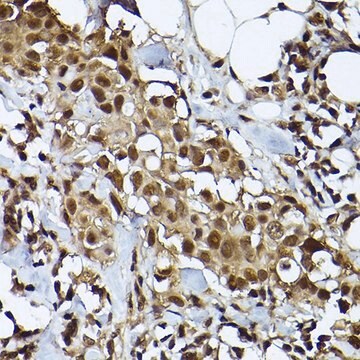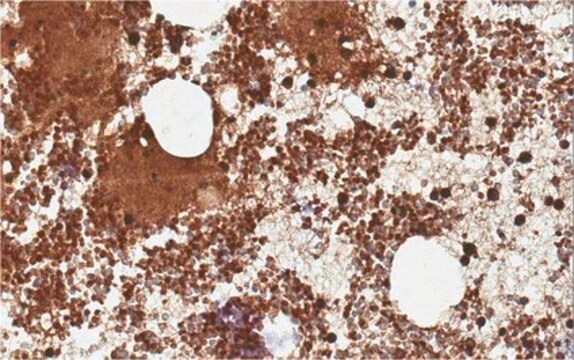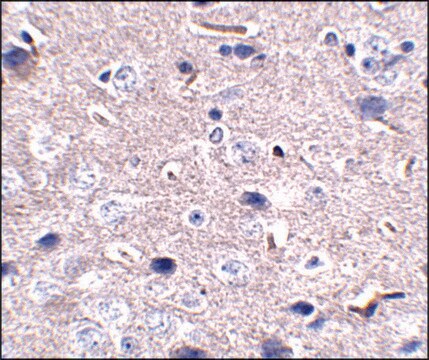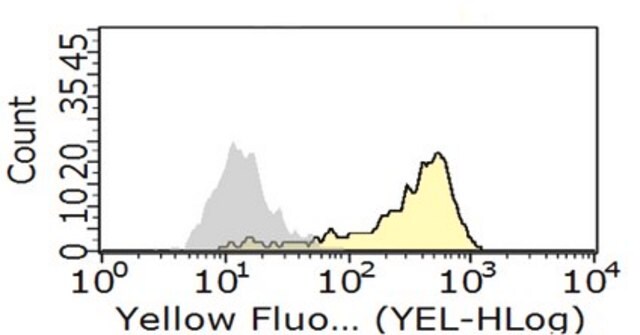MABF842
Anti-FcγRIIb/c Antibody, clone 4F5
clone 4F5, from mouse
Synonim(y):
Low affinity immunoglobulin gamma Fc region receptor II-b/c, IgG Fc receptor II-b/-c, CD32, CDw32, Fc-gamma RII-b/-c, Fc-gamma-RIIb/c, FcRII-b/-c
About This Item
Polecane produkty
pochodzenie biologiczne
mouse
Poziom jakości
forma przeciwciała
purified immunoglobulin
rodzaj przeciwciała
primary antibodies
klon
4F5, monoclonal
reaktywność gatunkowa
human
metody
flow cytometry: suitable
immunocytochemistry: suitable
immunohistochemistry: suitable (paraffin)
immunoprecipitation (IP): suitable
western blot: suitable
izotyp
IgG1κ
numer dostępu NCBI
numer dostępu UniProt
Warunki transportu
dry ice
docelowa modyfikacja potranslacyjna
unmodified
informacje o genach
human ... FCGR2B(2213)
Powiązane kategorie
Opis ogólny
Specyficzność
Immunogen
Zastosowanie
Flow Cytometry Analysis: A representative lot was conjugated with Alexa Fluor™ 647 and detected (at 10 µg/mL) FcγRIIb/c immunoreactivity among the CD19+ B lymphocytes population in human whole blood (Courtesy of Dr. Jeffrey C. Edberg, University of Alabama at Birmingham, USA).
Flow Cytometry Analysis: A representative lot was conjugated with Alexa Fluor 488 and detected FcγRIIb/c immunoreactivity on the surface of EBV-transformed human B cells from various donors (Li, X., et al. (2013). Sci. Transl. Med. 5(216):216ra175).
Flow Cytometry Analysis: A representative lot was conjugated with Alexa Fluor 488 and employed to detect FcγRIIb expression on various human PBMC populations. Highest FcγRIIb level was found on CD19+ B lymphocytes, while lower expression was found among CD14+ monocytes/neutrophils and CD3+ T-cells were negative of FcγRIIb staining (Su, K., et al. (2007). J. Immunol. 178(5):3272-3280).
Flow Cytometry Analysis: Clone 4F5 hybridoma supernatant immunostained murine B lymphoma IIA1.6 cells expressing exogenously transfected human FcγRIIb, but not any of the two polymorphic forms of human FcγRIIa with either Arg131 or His131 (Su, K., et al. (2007). J. Immunol. 178(5):3272-3280).
Immunoprecipitation Analysis: A representative lot immunoprecipitated both FcγRIIb and FcγRIIc from EBV-transformed human B cells and primary human CD19+ cells (Li, X., et al. (2013). Sci. Transl. Med. 5(216):216ra175).
Immunoprecipitation Analysis: A representative lot immunoprecipitated exogenously expressed human FcγRIIb, but not any of two polymorphic forms of human FcγRIIa with either Arg131 or His131 from murine B lymphoma IIA1.6 transfectants expressing the respective human proteins (Su, K., et al. (2007). J. Immunol. 178(5):3272-3280).
Western Blotting Analysis: A representative lot detected exogenously expressed human FcγRIIb, but not any of two polymorphic forms of human FcγRIIa with either Arg131 or His131 in lysates from murine B lymphoma IIA1.6 transfectants (Su, K., et al. (2007). J. Immunol. 178(5):3272-3280).
Immunocytochemistry Analysis: A representative lot was conjugated with Alexa Fluor 488 and detected FcγRIIb/c immunoreactivity on the surface of EBV-transformed human B cells from various donors (Li, X., et al. (2013). Sci. Transl. Med. 5(216):216ra175).
Functional Analysis: Cross-linking by goat anti-mouse IgG (GαM) of clone 4F5 F(ab′)2-bound human FcγRIIb and endogenous surface IgG-BCR on IIA1.6 murine B lymphoma cells expressing transfected human FcγRIIb resulted in a reduced calcium response than that triggered by GαM in the absence of clone 4F5 F(ab′)2. Cross-linking of FcγRIa with clone 4F5 F(ab′)2-bound human FcγRIIb on the surface of U937 cells likewise reduced the calcium response triggered by FcγRIa cross-linking alone (Su, K., et al. (2007). J. Immunol. 178(5):3272-3280).
ELISA Analysis: Clone 4F5 hybridoma supernatant detected recombinant extracellular domain (EC) of human FcγRIIb, but not any of the two polymorphic forms of recombinant human FcγRIIa ECs with either Arg131 or His131 (Su, K., et al. (2007). J. Immunol. 178(5):3272-3280).
Inflammation & Immunology
Immunoglobulins & Immunology
Jakość
Immunohistochemistry Analysis: A 1:50 dilution of this antibody detected FcγRIIb/c immunoreactivity in Islets of Langerhans in human pancreas tissue sections.
Opis wartości docelowych
Postać fizyczna
Przechowywanie i stabilność
Handling Recommendations: Upon receipt and prior to removing the cap, centrifuge the vial and gently mix the solution. Aliquot into microcentrifuge tubes and store at -20°C. Avoid repeated freeze/thaw cycles, which may damage IgG and affect product performance.
Inne uwagi
Informacje prawne
Oświadczenie o zrzeczeniu się odpowiedzialności
Nie możesz znaleźć właściwego produktu?
Wypróbuj nasz Narzędzie selektora produktów.
Kod klasy składowania
12 - Non Combustible Liquids
Klasa zagrożenia wodnego (WGK)
WGK 2
Temperatura zapłonu (°F)
Not applicable
Temperatura zapłonu (°C)
Not applicable
Certyfikaty analizy (CoA)
Poszukaj Certyfikaty analizy (CoA), wpisując numer partii/serii produktów. Numery serii i partii można znaleźć na etykiecie produktu po słowach „seria” lub „partia”.
Masz już ten produkt?
Dokumenty związane z niedawno zakupionymi produktami zostały zamieszczone w Bibliotece dokumentów.
Nasz zespół naukowców ma doświadczenie we wszystkich obszarach badań, w tym w naukach przyrodniczych, materiałoznawstwie, syntezie chemicznej, chromatografii, analityce i wielu innych dziedzinach.
Skontaktuj się z zespołem ds. pomocy technicznej







